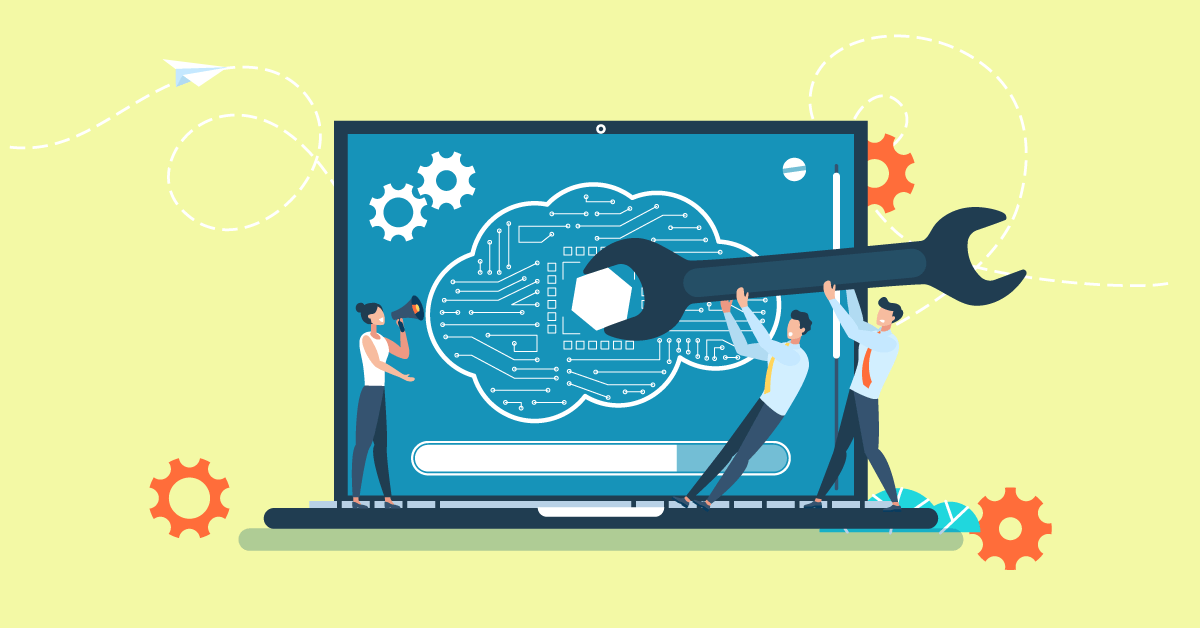The way businesses operate, especially in marketing and web development, has changed due to Artificial Intelligence. AI tools assist organizations in making better decisions, optimizing processes, and increasing efficiency, as their analysis of real-time data is impressively fast.
The immersion of AI tools in the workplace
Doom predictions around AI and robots taking over our jobs are vast worldwide. The truth is, however, that AI tools can significantly contribute to and assist in our daily tasks.
Let’s examine some of the core benefits AI tools have to offer.
Automation
AI systems can perform repetitive tasks once handled by employees. As a result, companies save up resources, money, and time. A great example is AI chatbots, which can simultaneously have conversations with multiple customers and assist each one.
Decision making
With the help of AI data analysis tools, companies can have real-time insights and gain access to micro and macro data faster than ever before. Management and leadership can view the analytics through these tools and use the reports to make data-driven decisions without having to analyze the info manually.
Problem-solving
Using AI tools makes identifying and solving problems more effectively a rather effortless process. Such tools can notice even minor changes in patterns, isolate trends, pinpoint changes in customer behavior, and more. Businesses can have all this big data at their fingertips without relying on data scientists to overcome challenges.
Reduced turnover
One of the biggest challenges of companies is employee turnover. With the help of AI in the workplace, it’s easier for businesses to create stress-free work environments where employees can perform their tasks with ease.
AI tools have the ability to analyze each employee’s work patterns, predict upcoming deadlines, and help them prioritize their tasks. As employees optimize their work schedules based on productivity patterns’ insights with the help of artificial intelligence, burnout, and stress levels reduce.
Or, you can provide better AI employee training catered to your teams’ specific needs by leveraging AI tools to gather valuable insights on employee skills gaps, level of expertise, way of learning, and performance. A continuous learning environment helps your people grow and develop, which results in high retention rates.
Productivity boost
As many repetitive, time-consuming tasks can be automated with the help of AI tools, employees can focus more on more complex tasks in their day-to-day. Instead of working on manual tasks, employees can focus on boosting their creativity,, critical thinking, and expertise. This results in better productivity among your teams.
Do we really need AI employee training?
Tools like ChatGPT are quite intuitive. And, after all, they’re designed to understand natural language and give human-like responses. So, (why) do we need training on how to use them?
In a TalentLMS survey, 49% of respondents said they need AI employee training on how to use AI tools before using them effectively.
Also, 51% of respondents who have already used ChatGPT at work admit needing training on AI tools, while only 18% have received such training.
Such statistics demonstrate that there’s a significant gap in businesses being well-prepared for the AI revolution. There’s an urgent need to train employees on how to use AI tools for work purposes.
It’s essential for companies to support their people on how to use AI tools because training assists employees in:
- Practicing critical thinking and identifying inaccurate information
- Protecting sensitive company data
- Unlocking the fullest potential of AI tools’ capabilities
- Understanding the power of these tools (instead of being scared they’ll lose their jobs over “robots”)
- Enhancing creativity (e.g., by crafting better prompts) and not relying on ready-made solutions
- Eliminating tech same (not all people in companies are tech-savvy or know by intuition how to use such tools)
Training employees on how to use AI tools
Artificial intelligence is expanding fast, and businesses can reap all the benefits it has to offer.
But AI tools can’t just solve your company’s problems in a heartbeat. They can only be effective when employees have the right skills to use them.
By investing in a well-planned employee training program on how to use AI tools, businesses can support their people in effectively using them. Through such training programs, employees can better understand AI, its benefits, how they can be seamlessly integrated and deployed, and pitfalls to avoid.
Identify training needs
The first and most crucial step for designing and developing a training program on how to use AI tools is to explore and identify your business and employee needs. Each business operates differently and has unique needs when it comes to automating processes.
Also, it’s important to examine what people already know and discover what they’d want to learn from their training program.
Conduct surveys, mini-tests, or assessments to clearly understand which training needs should be covered. Then, carefully analyze your collected data to set the basis for your training program on how to use AI tools.
Provide employee training programs
Organizations must create and provide training programs to assist employees with using AI tools in the workplace.
Let’s explore some of the best ways to provide effective employee training on using AI tools:
- Online training: Create online training modules through your LMS that cover the essentials of using AI tools at work. Employees can have a well-rounded training experience no matter their work model (remote, hybrid, or in-office). By creating detailed training modules on your LMS, you help learners go through theory and put what they learn into practice through assessments and quizzes.
- Workshops: Run a series of workshops (online or on-site) where employees can interact with AI experts and delve into the world of AI in detail. Trainers (in-house or external) will teach the fundamentals of using AI tools, provide hands-on practice with AI tools, and conduct and monitor discussions at the end of the workshop session.
- Online resources: Allow employees to have access to resources on how to use AI tools. Such resources include courses, tutorials, or webinars and are useful when employees need a brief overview of the material covered or a refresher.
- On-the-job learning: When your employees have the chance to work on AI-related tasks, they can better understand how AI tools can be applied to their day-to-day. Through on-the-job AI employee training, people can ask questions right when they’re hands-on with the project. Also, they can provide instant feedback and thoughts that can help optimize the training process on how to use AI tools.
- Continuous learning: Technology training can never be a one-time thing. With continuous learning opportunities, you allow employees to catch up with tech developments and stay ahead of the trends.
Evaluate your AI employee training program
After AI employee training, you want employees to use AI tools to boost productivity while avoiding common pitfalls like relying on inaccurate data. You’ve put time, resources, and effort into building a training program that supports their knowledge improvement for using AI.
In order to be sure about the effectiveness of your training program on how to use AI tools, you must evaluate it after its completion.
Collect learner data through your LMS by exploring training and assessment reports, conducting surveys or feedback sessions, and carefully examining your data. How many employees attended the courses or workshops? How well did they do on their quizzes? Are there any specific points that need extra elaboration?
These insights can help you understand if training on how to use AI tools is successful and if there are any areas for improvement that you should consider.
Mastering the world of AI
AI is not that big of a buzzword anymore. In fact, AI tools are a breakthrough in business and beyond.
And this is why they shouldn’t be scary. They’re the tools that can take your business to the next level if used correctly.
But the key to deeply understanding and using AI is through continuous learning. So, AI employee training on how to use such tools in the workplace is essential for reaching success in businesses and employee development alike.



